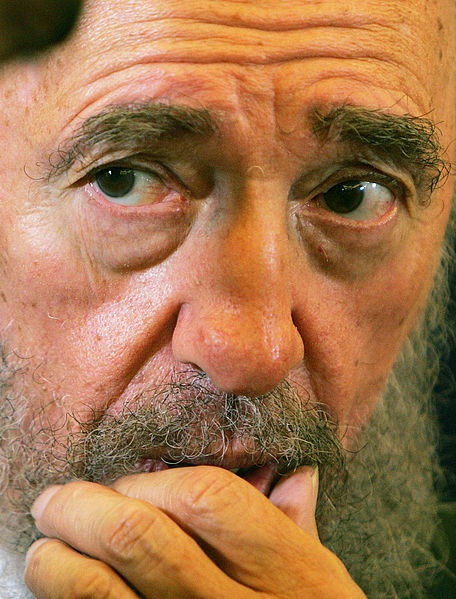The Cuban Missile Crisis was a period of thirteen days of high tension between the US and NATO on one side and the USSR and Cuba on the other. The crisis began when the US found out that the Soviets had moved missiles capable of reaching the mainland United States into Cuba, some 100 miles from the US shore. This led to days of diplomatic activity, military preparations, and high-level, high-risk correspondence between senior leaders in the USSR and USA - and nearly led to nuclear war.
However, the underlying reasons for the crisis were complex: these included that the USSR wanted to threaten and compete more effectively with the USA, the involvement of the USSR and the US in the Korean War and Vietnam War, strategic imbalance between the two sides, and the division of Berlin.
Nicky Quinton explains.
A picture of the US Jupiter intermediate-range ballistic missile, which were partly responsible for the Cuban Missile Crisis.
Background
The political relationship between the United States and the USSR after World War II was filled with tension. Two geographical giants were competing for economic, technical, and military superiority all over the world. Government policies were aimed at improving performance in various fields to tip the balance of power in their favor, even to the detriment of their citizens. The space race, nuclear arms race, and even the Olympic Games were proof that the US and the Soviet Union did not want to give an inch in the battle.
After World War II, the world was largely divided into two camps: those who supported capitalism and those who supported communism. The United States and the Soviet Union were the leaders of these two groups. Unfortunately, this confrontation was not limited to an informational and ideological war. Instead, the two states got involved in wars to support their ideological allies.
This was because neither the USA nor the USSR truly wanted to fight each other directly – the desire to avoid another World War and the risks from nuclear weapons helped prevent that. However, their armies fought indirectly in conflicts, notably the Korean War and Vietnam War.
Korean War and Vietnam War as examples of indirect war
The split of Korea after World War II into two independent states was driven by the Cold War. A socialist regime was established in the northern state, and a capitalist regime was established in the southern state. The Soviet Union (and China) supported the communist leader Kim Il-sung, and the US supported the anti-communist leader Syngman Rhee. The war began in 1950 and ended up with the Korean Armistice Agreement in 1953.
The Vietnam War is another example of a proxy war. Although the official conflict took place between North Vietnam and South Vietnam, the real state of affairs was similar to the Korean War. The USSR and China supported communist North Vietnam, and the United States and other anti-communist countries more actively supported South Vietnam. Therefore, indirect conflicts increased the tension between the USA and the Soviet Union during the Cold War.
Cuban Missile Crisis
The Cuban Missile Crisis was different to those wars – it was partly about strengthening the Soviet position and giving it a more credible nuclear threat.
It could happen at all because in the years before 1962 the Cuban Revolution led communist leader Fidel Castro to take control of Cuba in 1959. The Soviets were more than happy with an ally some 100 miles from the US coast and used it to their advantage.
The Soviet initiative to place missiles in Cuba was the result of the Soviet’s perceived strategic imbalance, since the United States had nuclear weapon bases in Turkey, close to the Soviet Union (Nathan, 58). In 1961, US President John F. Kennedy agreed to put 15 nuclear-tipped Jupiter missiles near the Turkish border. While the US military was deemed capable of delivering a first strike on the USSR (launching a nuclear attack before the enemy could do the same), the Soviets had few ballistic missiles deemed capable of reaching the continental US from the USSR at the time. Furthermore, these were considered to be both inaccurate and unreliable (Allison and Zelikow, 92). Therefore, the USSR wanted to solve this problem by placing mid-range missiles in Cuba, thus restoring the strategic balance.
One more crucial reason for the Crisis was Berlin. During the Cold War, Germany was effectively split into two: East Germany (GDR) and West Germany (FRG). The border went straight through Berlin. Soviet leader Nikita Khrushchev believed that by having missiles in Cuba, the Soviet Union could try and strike a deal with the West into relinquishing its control over the western portion of Berlin (Allison and Zelikow, 105).
In short, some of the key reasons for the Cuban Missile Crisis were:
· The Cuban Revolution that led communists to take charge of Cuba
· Political competition between the USA and the Soviet Union.
· Growing tensions throughout the 1950s, partly driven by the Korean War and the (early days) of the Vietnam War
· To put pressure on the United States to remove its nuclear arms from Turkey
· Control over Berlin
Conclusion
Crisis was averted in Cuba and the US did in fact secretly later remove the nuclear-tipped missiles from Turkey (Nathan 134). Fortunately the Cold War didn’t turn into a “hot war.”
Works Cited
Allison, Graham T., and Philip Zelikow. Essence of Decision: Explaining the Cuban Missile Crisis. TPB, 2000.
“Cuban Missile Crisis.” History.com, A&E Television Networks, 8 May 2019, www.history.com/topics/cold-war/cuban-missile-crisis.
Nathan, James A. The Cuban Missile Crisis Revisited. St. Martin’s Press, 1992.
What do you think of the article? Let us know below.
This article was provided by Nicky Quinton of WriteMyEssayOnline.
Editor’s note: That external link is not affiliated in any way with this website. Please see the link herefor more information about external links.



















